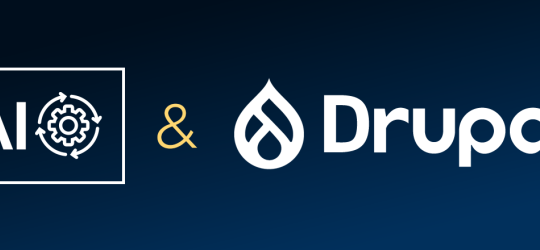Automating Content Creation and Publishing with AI in Drupal.
AI-Powered Drupal - A Guide to Intelligent CMS Evolution - Part 3
Read Part 1: AI and Drupal: Overview and Key Trends – The Present and Future of Automation
Read Part 2: Personalization Powered by AI in Drupal – Tailoring User Experiences

Content Generation with AI
Content is king – but creating content can be time-consuming and labor-intensive. Enter AI-powered automation. In Drupal, AI tools help generate and manage content more efficiently than ever. Imagine having a virtual assistant that drafts articles, suggests images, tags content with relevant keywords, and schedules publishing, all while you focus on strategy and quality control. This section discusses how AI automates various aspects of content creation and publishing in Drupal, exploring available tools, their workings, and best practices to maintain high content standards.
AI Tools for Generating Content in Drupal
- Drupal AI Framework (https://www.drupal.org/project/ai): Introduced in late 2024, this framework integrates multiple AI services like OpenAI, Anthropic, and Hugging Face directly into Drupal, supporting enhanced text generation, AI-assisted semantic search, automated content moderation, and multilingual translation workflows. A full list of supported AI service can be found on the project page.
- Text Generation: Modules such as the OpenAI Provider (https://www.drupal.org/project/openai) enable AI-generated drafts, headlines, or summaries. For instance, a Drupal-based recipe site can automatically generate descriptions or instructions from ingredient lists. The Drupal OpenAI module has gained significant popularity in recent months, largely fueled by the widespread interest in ChatGPT and generative AI technologies. Its growing relevance was further highlighted by its inclusion in sessions and discussions at recent DrupalCon events, showcasing how the module integrates powerful AI tools directly into Drupal workflows.
- Image Generation and Selection: Modules like Image Genie AI (https://www.drupal.org/project/ai_image_generation) integrate tools such as DALL·E, turning text prompts into visuals instantly. AI also assists in suggesting images from media libraries, reducing the time spent sourcing visuals.
- Multilingual Content Translation: AI-driven modules like AI Translation Management (TMGMT) (https://www.drupal.org/project/tmgmt) integrate cloud-based translation APIs, swiftly translating content into multiple languages. Human reviews are recommended for accuracy.
- Content Variations and Tone Adjustments: AI facilitates rewriting content in various styles or tones, enabling easy repurposing across different channels—from formal press releases to informal social media updates.
Automating Tagging and Content Management
- Auto-tagging and Categorization: AI analyzes content and suggests relevant taxonomy tags, enhancing SEO and content discoverability. AI-driven image recognition ensures accurate tagging of visual content.
- Content Categorization and Routing: AI systems analyze and appropriately route incoming content based on topics, streamlining content management in multi-author setups.
- Metadata Generation: AI generates essential metadata such as meta descriptions and image alt texts automatically, ensuring consistent and comprehensive content indexing.
- Content Audits and Updates: AI assists with periodic content audits, identifying outdated content, broken links, or obsolete information. Future developments may enable advanced semantic checks against current data sources.
Streamlining Publishing Workflows
- Scheduling and Optimal Timing: AI analyzes site analytics to recommend optimal publishing times, enhancing content visibility and user engagement.
- Approval Workflow Assistance: AI helps manage multi-step approval processes, sending reminders and automating compliance checks to streamline content workflows.
- Content Alerts and Summaries: AI-generated summaries and alerts inform site admins about new submissions, pending reviews, and scheduled posts, facilitating efficient content management.
- Version Control and Change Suggestions: AI tracks content revisions and suggests improvements based on historical edits, ensuring consistent editorial quality.
Best Practices and Considerations
- Always Review AI-Generated Content: Human oversight remains critical, as AI-generated outputs may contain inaccuracies or lack alignment with organizational voice. AI can produce information that is outdated, especially in fast-evolving fields like web development. The internet is a vast archive of both current and legacy technologies, and without human review, AI may surface solutions or examples that are no longer relevant or secure. Ensuring content is accurate, timely, and aligned with best practices requires informed human judgment.
- Maintain Editorial Guidelines: Clearly document content styles and rules for consistent AI performance. The better context provided to AI, the higher quality output it produces.
- Monitor for Bias and Consistency: Remain vigilant against unintended biases introduced by AI, ensuring content consistency across multiple team members using AI tools.
- Versioning and Backups: Enable Drupal revisions for robust version control, providing a safety net for automated bulk-edits or unintended changes.
- Train and Educate Your Team: Equip the content team to effectively collaborate with AI, enhancing overall productivity and output quality.
- Tactis’ Perspective on Content Authenticity: Maintain authenticity by using AI to handle repetitive tasks, allowing human creators to focus on creativity, strategy, and audience connection. At Tactis, we advise leveraging AI tools to empower human-centric activities, maintaining content authenticity and quality.
A More Efficient Content Operation
By embracing recent advancements in Drupal’s AI automation—such as the Drupal AI Framework, OpenAI Provider Module, AI Translation Management, and Image Genie AI—content teams can significantly enhance productivity, consistency, and quality. Automating routine tasks frees teams to focus on strategy and creativity, transforming content operations into agile, intelligent workflows.
For detailed information and access to the mentioned modules and tools, visit drupal.org.